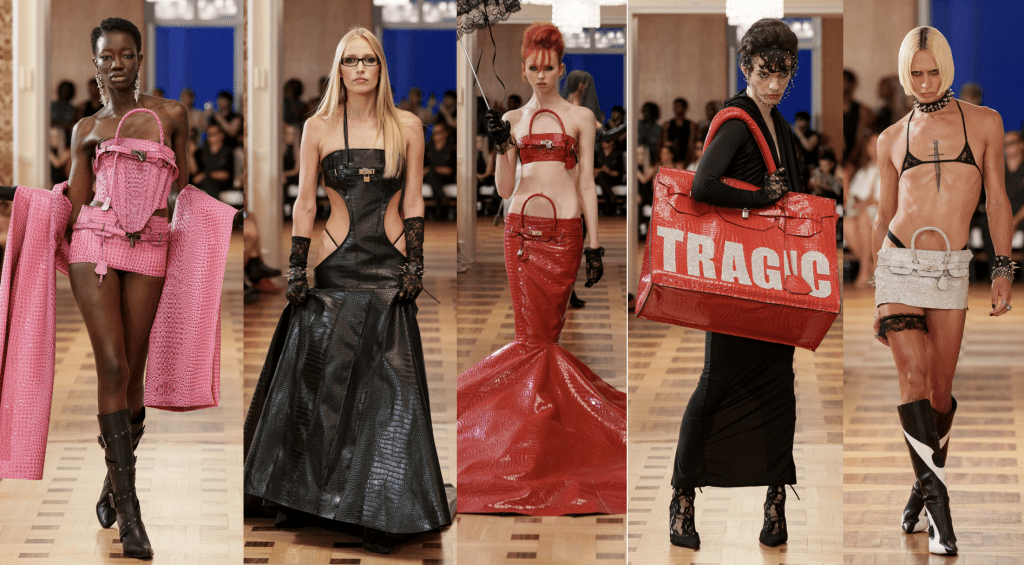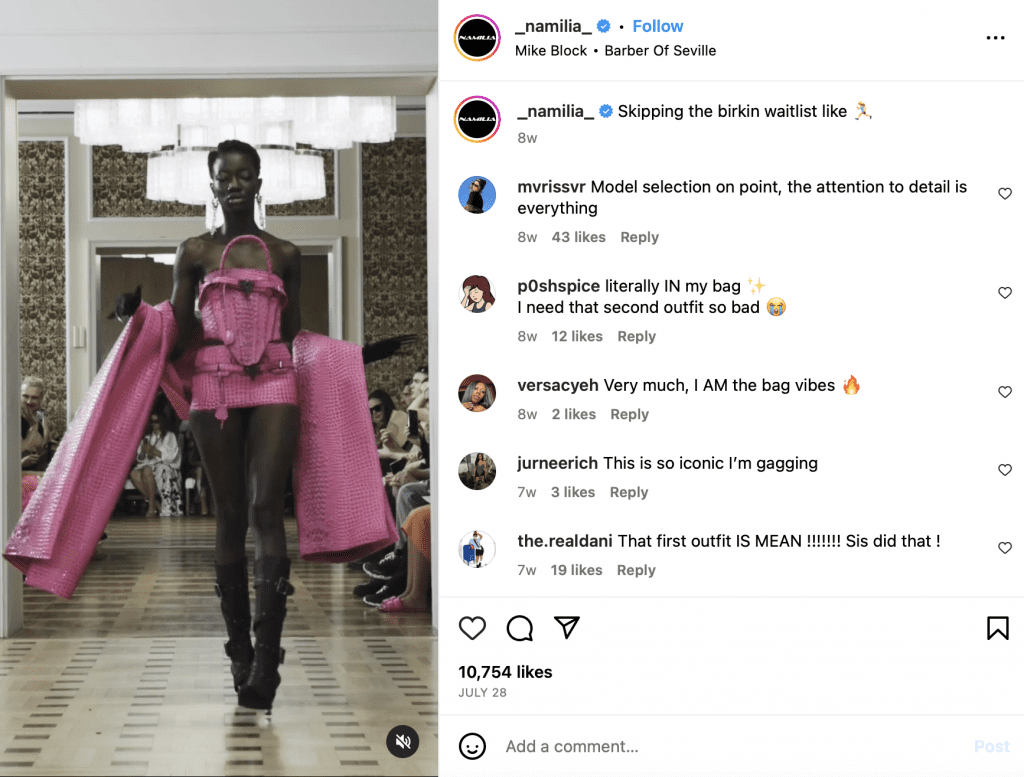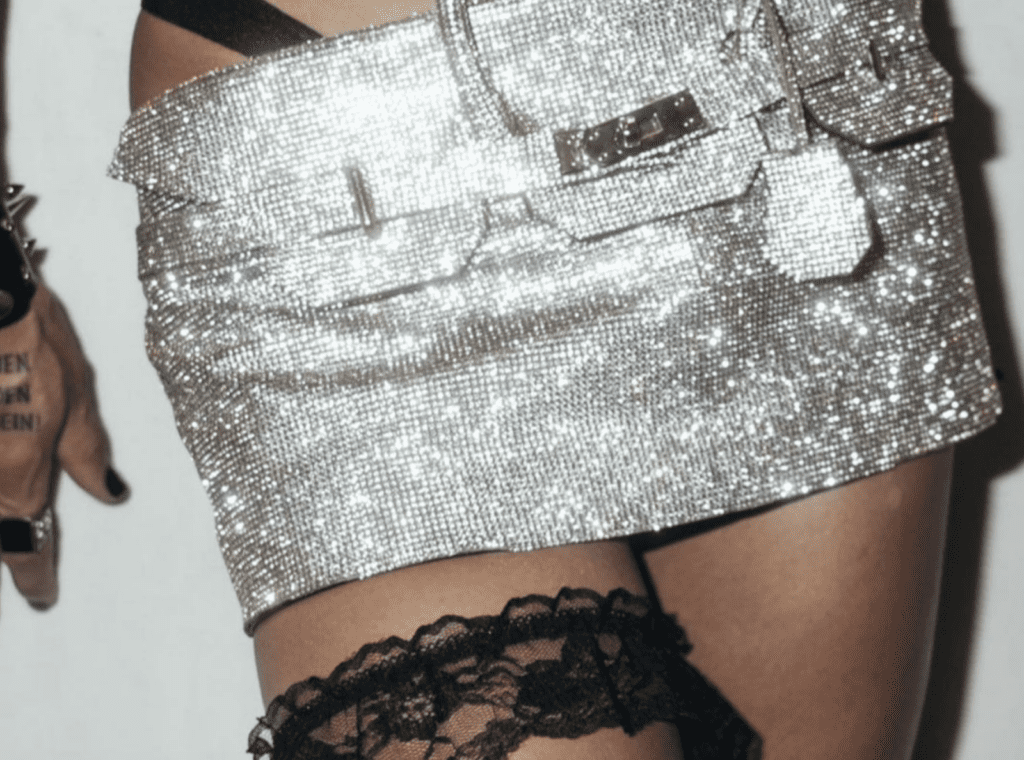Hermès has been handed a loss in its attempt to stop a Berlin-based fashion brand from using the design of its famed Birkin bag and the “BIRKIN” trademark. In a newly-issued decision, the District Court in Frankfurt dismissed Hermès’s bid for a temporary injunction, finding that it failed to “substantiate any claim for an injunction” over Namilia’s use of the Birkin bag design trademark and corresponding “BIRKIN” word mark, and thus, cannot block Namilia from depicting imagery from its S/S24 fashion show online, and in particular, on Instagram, as the brand’s use of the marks amounts to artistic activity.
Some Background: The parties’ legal squabble follows from the debut of Namilia’s S/S 2024 collection in July, in which designers Nan Li and Emilia Pfohl presented tops, dresses, and skirts, as well as handbags, that mirrored elements from Hermès’s trademark-protected Birkin bag design. (Hermès’s Birkin trademark consists of: “the configuration of a handbag, having rectangular sides a rectangular bottom, and a dimpled triangular profile … [a] top that consists of a rectangular flap having three protruding lobes, between which are two keyhole-shaped openings that surround the base of the handles … [a] flap [that includes] a horizontal rectangular strap having an opening to receive a padlock eye, [and] a lock in the shape of a padlock forms the clasp for the bag at the center of the strap.”)

Additionally, Namilia – which has become known for its commentary on political and societal issues – used the “BIRKIN” word mark in connection with its coverage of the collection on Instagram, prompting Hermès to send the brand a cease-and-desist letter this summer and then initiate the injunction proceeding. Hermès sought injunctive relief to prevent Namilia from continuing to display images of the collection online, and in a decision on September 19, the Frankfurt District Court held that Hermès “cannot, on the basis of its 3-D European Union trademark [for the Birkin bag design], demand that [Namilia] cease and desist from depicting [its] ‘fashion show’ on the internet.”
Freedom of Property vs. Expression
Setting the stage in its decision, as first reported by TFL, the Frankfurt District Court stated that in order to determine whether injunctive relief was warranted, it had to consider both Hermès’s freedom of property (under Art. 12 GG, Art. 17 GR Charter in conjunction with Art. 6 EUV) and Namilia’s freedom of art (under Art. 5 (3) GG, Art. 13 GR Charter). According to the court, “Use of a trademark by a third party for artistic purposes should be considered lawful” as long as it is used “in accordance with honest practices in industrial or commercial matters.” The court held that the right to freedom of expression must also be taken into account.
This balancing tips in favor of Namilia, the court found, holding that “the presentation of the fashion show, which is rooted in artistic freedom, outweighs [Hermès’s] property right” in its Birkin bag trademark.
Turning to the issue of “whether the distinctive character of a mark” – Hermès’s Birkin bag design mark here – is “taken unfair advantage of,” the court asserted that this must be assessed with a “comprehensive evaluation of all relevant circumstances,” which include “the extent to which the mark is known and the degree of distinctiveness of the mark, the degree of similarity of the conflicting signs, as well as the nature of the goods and services concerned and the degree of their proximity.” At the same time, the court stated that “exploitation of the distinctive character of a mark with a reputation is to be assumed if a third party, by using a sign similar to a mark with a reputation, seeks to [piggyback on the appeal of that mark], its reputation and its prestige without any financial consideration and without making any effort of its own.”

Without delving into each individual factor, the court held that Namilia’s designs are “works of art protected by Art. 5 GG and Art. 13 GR Charter.” The court focused on the fact that Namilia “presented a production … that is thematically about female stereotypes and the acceptance of prejudices as a form of feminism. In this exaggerated social portrayal, the women carry bags reminiscent of Birkin Bags, not only as purses but also as tops, dresses, and skirts in a provocative and lascivious manner.” In furtherance of the collection, Hermès’s Birkin bag designs “serve precisely as status symbols and embody luxury,” according to the court, and the inclusion of “some defining elements, such as the characteristic buckle of a Birkin bag,” within the clothing items, themselves, “is a supporting element of the performance.”
The court noted that artistic freedom is limited by “conflicting fundamental rights, such as the guarantee of ownership, which covers [Hermès’s] trademark rights.” Nonetheless, “with the weighing to be carried out, [Hermès’s] guarantee of ownership takes a back seat here.” The reason, according to the court, is that Namilia is not selling the garments at issue. (While one of the designs from the collection (a micro-mini skirt that bears some of the same elements as the Birkin design) made its way on to Christina Aguilera, who posted a photo of herself in it on Instagram on July 31, Namilia may have been gifted or lent the skirt to the singer, thereby, still enabling it to say that it has not offered up the collection for sale.)
The court asserted that Hermès is “not without protection” should Namilia start selling the garments that contain the Birkin-inspired elements. In that case, Hermès could initiate new proceedings to enforce its trademark rights.
In one final determination, the court found that Namilia’s use of the Birkin designs does not “denigrate or disparage” Hermès’s trademark. Instead, such use “serves as the reference point of luxury goods that society aspires to,” the court stated. Beyond that, the court maintained that “the reference to the Birkin bag is only one part of the overall staging” and that in using the Birkin bag design, Namilia “reinterprets” them in its “own artistic performance and does not enter into the pull effect of [Hermès’s] trademark, [which] serves solely as a means to an end.”
Turning to Hermès’s objection to Namilia’s use of the “BIRKIN” word mark in its Instagram posts, the court held that this is “also covered by artistic freedom … because the images are photos from the show in which [Hermès’s] trademark was used in a descriptive manner.”
An appeal against the court’s decision can still be filed by Hermès.
THE BIGGER PICTURE: Not Hermès’s only pending legal battle over the Birkin bag design and word mark, Hermès filed suit against Mason Rothschild for his use of the Birkin trademarks in connection with a collection of NFTs, with a New York jury siding with Hermès in a verdict early this year. Rothschild has since lodged an appeal with the U.S. Court of Appeals for the Second Circuit. Both cases (and others) amount to attempts by Hermès to take a strong hand against others’ unauthorized uses of the trademarks associated with its most famous offering and arguably, the biggest driven of its brand, overall.
The case is Hermès v. Namilia, 2-06 O 533/23 (LG Frankfurt am Main).











